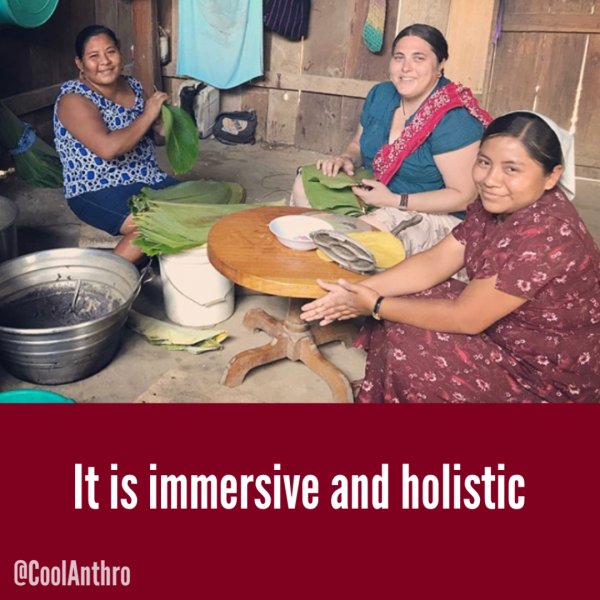Ethnographic Methods
What is ethnography, anyway?
Jump to resources for conducting and teaching ethnography
Anthropology lives at the intersection of the social sciences and the humanities. In fact, we are often called the most humanistic social science, and the most scientific area of the humanities. Key to this ability to work across different disciplines and traditions is our primary methodology: ethnography. Though most anthropologists would agree that ethnography is key to the production of anthropological thought, its exact definition and methods are inherently flexible, allowing ethnographers to shape their methods to fit realities on the ground, rather than uncritically imposing outside theory on a cultural context.
Broadly, “ethnography” simply means “writing about people.” However, this broad definition applies to many methodologies and writing styles that we would not traditionally understand as ethnographic. This is because quality ethnography is based on long-term research through participant observation—living and working with people in order to gain an understanding of their reality—alongside social scientific methodologies like semi-structured interviews, focus groups, and surveys. This commitment to longterm, engaged participant observations gives ethnographers a unique vantage point from which to more confidently draw conclusions. That said, ethnography is much more than simply observing people and recording what they do. It requires great care, attention, and ethical commitment to those were are working alongside.
Interpersonal connection and “building rapport”
As with all human-centered methods, ethnography depends on the willingness and enthusiasm of our participants. Given the colonial legacy of early anthropology, many communities are understandably skeptical of the intentions of ethnographers who enter their communities. For this reason, ethnographic methods rely heavily on building genuine connections and relationships of trust with participants, and designing flexible, responsive, mutually beneficial methods. This means getting to know our participants and ethnographic context well enough to understand social norms governing communication, relevant conversations already happening in our field sites, and which methods will work—or not work—in each cultural context. It also means taking stock of and confronting our own identifies, beliefs, and preconceived notions as we research and write, a concept anthropologists call reflexivity.
Methodology and the body
Though we often discuss the importance of listening in anthropology, ethnographers should also be attuned to the wealth of non-verbal information that influences our research and conclusions. Why might a participant hesitate or wince when asked a certain question? How do participants express pain, excitement, joy, or displeasure? When observing interactions, how are people’s bodies positioned, how do they move, and what gestures do they use to communicate meaning? This embodied communication is often overlooked in favor of more tangible, verbal and textual data, but plays a crucial role in developing an analysis that goes beyond the superficial.
Similarly, ethnographers should take care to listen to their own bodies and instincts as well. Ethnographic fieldwork is exhausting, and requires great mental, and often physical, endurance. Ethnographers should ask themselves how their own levels of physical and social comfort influence their methods and conclusions. For example, how does exhaustion affect our ability to listen and process what our participants are telling us? Is there a reason that every interaction with a certain community member feels awkward or forced? How can these kinds of embodied knowledge increase or threaten our ability to conduct high quality research?
With great power comes great responsibility
The ability to observe and write about social groups is a privilege, one that grants us great power. As we produce knowledge about others, we must constantly strive to balance our scholarly interests with the interests of our participants. Further, we should be prepared for the reality that these participants may not always agree with our conclusions, and grapple with this in the most responsible and mutually beneficial way possible. This potential “pitfall” is actually one of the great strengths of the ethnographic method; by building genuine, close relationships with our participants, we are more able to work collaboratively with our participants to reach conclusions that reflect both our own observations and participants’ understandings of their own realities. Additionally, we must remain aware that participants’ world views may differ drastically from our own, which may in turn lead to different understandings of the potential benefits and risks of a given project.
Conclusion
At a cultural and historical moment in which conflict between differing world views, experiences, and realities seem to dominate so much of the public conversation, ethnographic methods—with their emphasis on slow, deliberate observation, interpersonal connection, and analysis informed by on-the-ground realities—are uniquely and powerfully positioned to help us make sense of the world around us, and to create positive change based on ethnographic analysis. In the words of the late Leith Mullins, one of the most influential voices in engaged anthropology:
Swipe to learn more about ethnographic methods!
Resources for conducting and teaching ethnography
“A template for writing fieldnotes” by Lorena Gibson
“How to Write an Essay: A Guide for Anthropologists” by Nicola Jones
“What is Ethnography? Teaching Ethnographic Sensibilities without Fieldwork” by Carole McGranahan
“Teaching Culture and Methods to Novice/Non-Anthropologists” by Lindsay A. Bell
“Teaching Ethnography through Theater” by Dana McLachlin
“The Fifty Minute Ethnography: Teaching Theory through Fieldwork” by Susanna Trnka













What do you think?